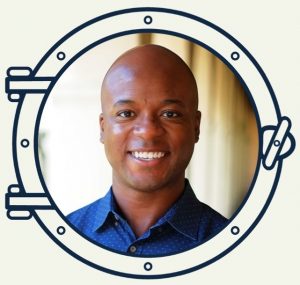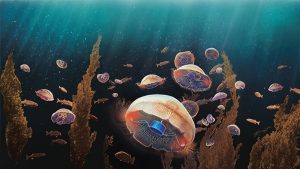

Charting a New Course: John Dabiri
This profile is part of our series celebrating contemporary Black geoscientists in honor of Black History Month. Learn more here.
Dr. Dabiri is a biophysicist and professor of engineering at Caltech, where his research on robotics, wind farm planning, and the mechanics of jellyfish swimming rupture any and all boundaries between the scientific disciplines. Among many other recognitions, he was awarded a MacArthur Genius Grant in 2010. Commenting on the award, he noted that it would allow him to continue to pursue his—in his own words—“unorthodox” research in biology, energy, and the environment.
Dabiri grew up in Ohio, with an engineer father. While he was always interested in engineering, he didn’t imagine more than anyone else that he would end up conducting the kind of unorthodox research he leads today. “I always thought I would end up working for Ford or GM or something like that … And it wasn't until I got to college that I realized that there's a lot more out there than just you know working for the local car company” he told NPR. During his time as an undergrad at Princeton, he had the opportunity to do a summer project at Caltech, where he became interested in how jellyfish swim. Before long, he was a graduate student at Caltech, completing his Ph.D. in bioengineering and aeronautics in 2005. He has been researching and teaching at both Caltech and Stanford ever since.
The principle of Dabiri’s work is that engineers can learn from the successes and failures of biological systems in order to better design engineered systems. His work on jellyfish swimming has led to the development of prototype biohybrid robots (a robotic control attached to a living jellyfish) as ocean monitoring devices. (If you’re curious about the ethics of such projects, as I was, his lab put out an article on this very topic here.) Inspired by how fish schooling lowers the energy costs for individual fish to swim, he has also developed plans for better-designed wind farms that cluster individual wind turbines into groups with a particular orientation to maximize the efficiency of energy production. You can learn more about Dabiri’s work on his lab website.

Artistic rendering of biohybrid jellyfish from Dr. Dabiri's website
We asked Dabiri what he would say to current STEM undergraduates wondering why they should use their training to study research questions in the geosciences: “I would emphasize the fact that we have difficult challenges ahead in predicting and coping with the impacts of climate change. We need new ideas and new perspectives in the geosciences in order to make better progress, and that will only happen if we can attract a broader set of undergraduates to the field.”
Read more of Through the Porthole Issue #1
Learn more about Through the Porthole
Learn more about the MIT-WHOI Joint Program